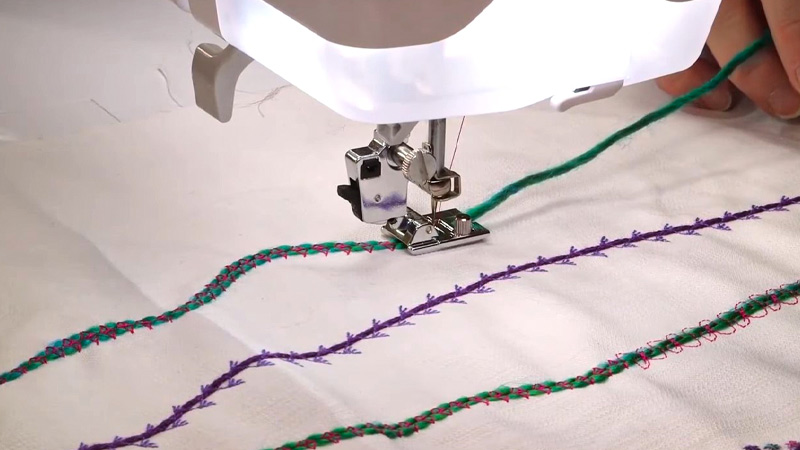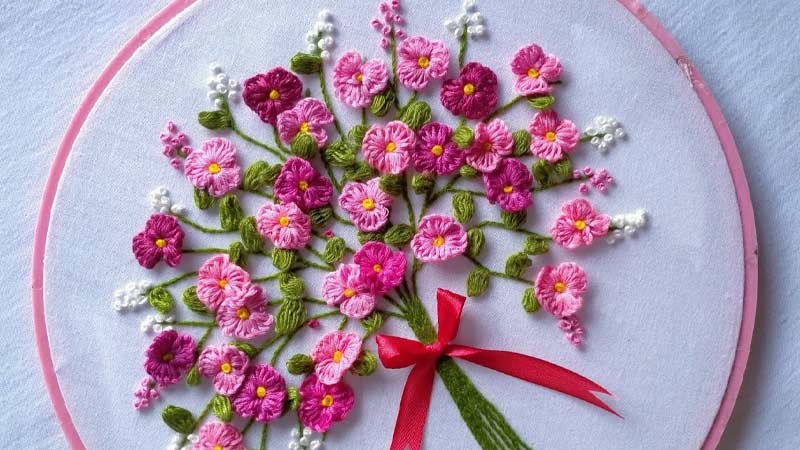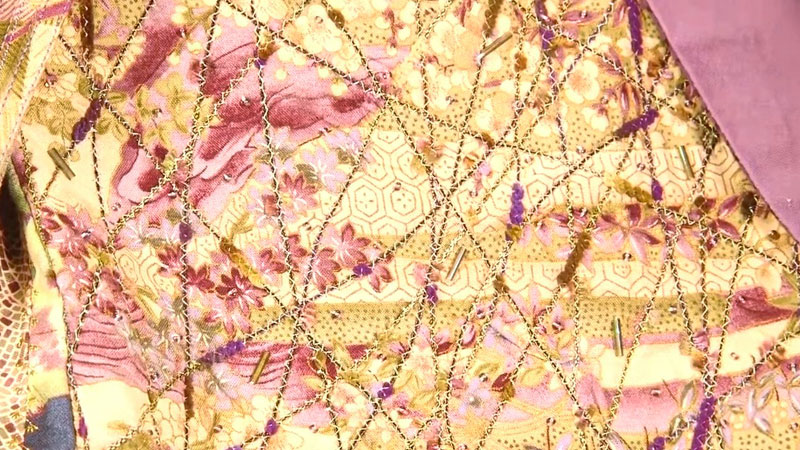Couching in sewing is a decorative technique that involves attaching a thick, often contrasting, thread to a fabric surface in decorative patterns. This creates textured embellishments and intricate designs, adding depth and visual interest to garments, accessories, or home decor items.
Historically, couching was a prominent feature in intricate embroidery, particularly during the Middle Ages and Renaissance periods. Today, it remains a versatile and creative method, with modern interpretations ranging from traditional to contemporary styles.
By employing various threads, yarns, and materials, couching allows for endless possibilities in customizing and personalizing sewing projects. This introduction provides a glimpse into the artful world of couching, inviting enthusiasts to explore its captivating potential.

What Is Couching in Sewing?
Couching in sewing is a technique used to attach decorative threads, cords, yarns, or other materials to fabric surfaces. It is a method that allows you to create textured and embellished designs on your sewing projects.
Couching can be used for a variety of decorative purposes, such as adding intricate patterns, outlines, or highlights to garments, home decor items, quilts, or accessories.
Here’s how couching typically works:
Prepare your materials
When selecting a base fabric, consider its weight and texture. Lighter fabrics may require more delicate threads, while heavier fabrics can handle thicker cords or yarns.
The decorative material you choose can greatly influence the final look. Consider using metallic threads for a glamorous effect, or experiment with different textures and colors to achieve the desired aesthetic.
Choose your design
Sketch out your design on paper or mark it directly on the fabric using fabric markers or chalk. This helps you visualize the placement of the decorative elements and ensures accuracy in execution.
Set up your sewing machine

If you’re using a couching foot, refer to your sewing machine’s manual for instructions on how to attach it properly. Ensure that the foot is securely in place before you begin sewing.
Adjust the stitch width to achieve the desired coverage over the decorative material. A wider zigzag stitch will secure the material more effectively.
Position the decorative thread
Take your time to carefully lay out the decorative thread or cord according to your design. You can use pins, clips, or temporary fabric adhesive to hold it in place. Pay attention to curves or intricate shapes, making adjustments as needed.
Start sewing
Begin sewing along the designated path, ensuring that the needle catches the decorative material in every stitch. Maintain a steady pace and guide the fabric with both hands to ensure even stitching.
Periodically check the tension and stitching to ensure that the decorative thread is securely attached. Adjust the machine settings if necessary.
Finish and secure
Once you’ve completed the design, secure the ends of the decorative thread. You can tie a knot, use a backstitch, or employ a securing stitch pattern to ensure the thread won’t unravel over time.
Trim any excess decorative material, taking care not to cut the base fabric.
Optional embellishments
To enhance the visual appeal of your couching, consider adding additional embellishments. Sequins, beads, or small fabric appliqués can be sewn or glued onto the design for extra flair.
Fun Couching Stitches Ideas for Embroidery
Embroidery is a wonderful way to add personality and creativity to your home decor.
Here are 10 fun and unique couching stitches design ideas for embroidery:
French Knots Bouquet

Create a stunning floral arrangement by crafting delicate flowers using French knots. To enhance the overall effect, use couching stitches to create the stems. Opt for a contrasting thread color to make the flowers pop and add depth to your bouquet.
Starry Night Sky
Transform your embroidery into a mesmerizing night sky filled with twinkling stars. Utilize couching stitches to secure thread or metallic floss to represent stars. Add an extra touch of magic by incorporating sequins or beads to mimic the shimmering cosmos.
Whimsical Animal Shapes
Outline whimsical animal shapes using couching stitches and let your creativity run wild. Fill these shapes with a variety of embroidery stitches like satin stitch or backstitch to bring these creatures to life, resulting in a playful and charming design.
Geometric Patterns
Explore contemporary designs by crafting geometric patterns with couching stitches. Experiment with different shapes, angles, and color combinations to create visually captivating and modern embroidery pieces.
Ombre Effect
Achieve a beautiful ombre effect by blending different shades of thread. Couch them in place, creating a gradual color transition that adds depth and dimension to your embroidery, resulting in a captivating gradient.
Seaside Scene
Transport yourself to the tranquil shores with an embroidered seaside scene. Depict waves, seashells, and a radiant sun using couching stitches for the waves’ fluidity and the sun’s rays. Your embroidery will capture the serene beauty of the beach.
Botanical Garden
Embroider is a lush botanical garden teeming with flowers and leaves. Use couching stitches to depict the natural elegance of stems and branches. Experiment with various floral shapes and colors to create an enchanting and vibrant garden.
Abstract Art
Unleash your inner artist and craft abstract designs using couching stitches. Play with a combination of shapes, lines, and patterns to form unique and expressive artwork, allowing your imagination to guide your stitches.
Mandala Magic
Delve into the mesmerizing world of mandalas by creating intricate and symmetrical designs. Employ couching stitches to outline the mandala’s elaborate patterns. Enhance its visual impact by using a contrasting thread color to make the design stand out.
Typography and Quotes
Personalize your embroidery by incorporating typography and inspiring quotes. Use couching stitches to carefully stitch out your chosen words in various fonts and styles, adding a meaningful and decorative touch to your projects.
Benefits of Couching in Sewing

Couching in sewing offers several benefits that make it a popular technique for adding embellishments to fabric.
Here are some of the key advantages:
Versatility
Couching can be applied to a wide range of fabrics, from delicate silks to heavy denim. This versatility allows for a diverse array of design options.
Texture and Dimension
Couching adds texture and dimension to your fabric, creating a three-dimensional effect. This can make your sewing projects more visually interesting and dynamic.
Customization and Creativity
It provides a platform for creativity and customization. You can experiment with different threads, cords, yarns, and colors to achieve unique and personalized designs.
Embellishment Variety
With couching, you can incorporate various materials into your designs, including metallic threads, ribbons, cords, and even unconventional items like rickrack or strips of fabric. This diversity of materials allows for a wide range of looks.
Highlighting Details
Couching is excellent for accentuating specific features or details on a garment or fabric piece. It can draw attention to seams, edges, or specific design elements.
Efficiency and Speed
Compared to some other embellishment techniques like hand embroidery, couching can be faster and more efficient, especially when using a sewing machine.
Durability
When done correctly, couching creates a secure attachment between the decorative material and the fabric. This ensures that the embellishments will remain intact even after washing or regular use.
Accessibility for Beginners
Couching can be a more accessible technique for beginners who may find intricate hand embroidery or other embellishment methods challenging. It’s relatively straightforward and can yield impressive results.
Cost-Effectiveness
Couching doesn’t typically require a large amount of decorative material, making it a cost-effective way to add flair to your sewing projects.
Adaptability for Various Projects
Whether you’re working on clothing, home decor, quilts, or accessories, couching can be applied to a wide range of projects, allowing you to incorporate this technique into many different types of sewing endeavors.
FAQs
What is couching in sewing?
Couching is a decorative stitching technique in sewing where a thicker thread, yarn, or cord is attached to a fabric surface to create intricate patterns and textures.
What materials can be used for couching?
Various materials can be used for couching, including specialty threads, yarns, ribbons, and even metallic cords. The choice of material allows for a wide range of creative possibilities.
How is couching different from other embroidery techniques?
Unlike traditional embroidery stitches that go through the fabric, couching involves laying a decorative thread on top of the fabric and securing it with parallel stitches, creating a raised, textured effect.
What types of projects can benefit from couching?
Couching can enhance a wide array of projects, including clothing, accessories like bags or hats, as well as home decor items like pillow covers, table linens, and wall hangings.
Is couching suitable for beginners?
Yes, couching can be a beginner-friendly technique in sewing. It requires basic stitching skills and offers a forgiving learning curve, making it an accessible choice for those new to embroidery and embellishment.
To Recap
In conclusion, couching in sewing offers a splendid avenue for artistic expression and embellishment. Its rich historical roots and contemporary adaptability make it a cherished technique for seasoned artisans and beginners alike.
The fusion of textures, colors, and materials enables boundless creativity, allowing crafters to infuse their unique touch into every project. Whether adorning garments, accessories, or home decor, couching adds an exquisite dimension that elevates the final result.
Embracing this technique unlocks a realm of possibilities, from intricate traditional designs to bold, modern statements. As a timeless art form, couching stands as a testament to the enduring allure of handcrafted creations in the realm of sewing and needlework.
Leave a Reply